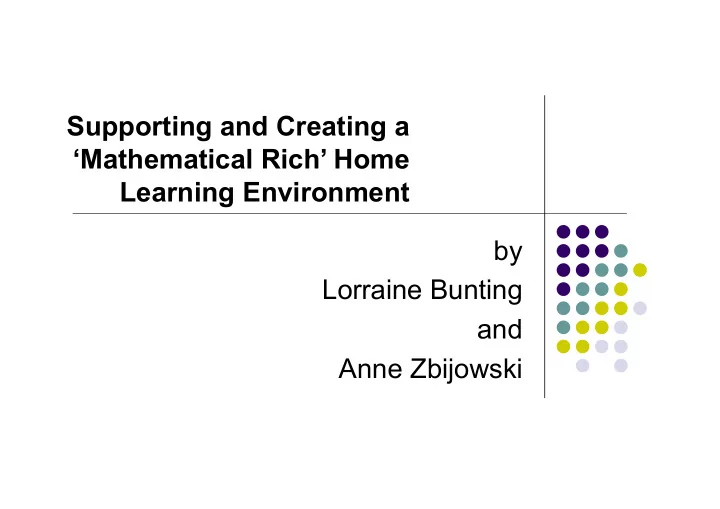

Supporting and Creating a ‘Mathematical Rich’ Home Learning Environment by Lorraine Bunting and Anne Zbijowski
Contents The Learning Process The Early Years Goals (40-60months) The Maths Sack The Role of the Parent Mathematical Language Supporting Children’s Counting Keeping Track of Counting Pause for Thought Changes the setting has made Final Thought
The Learning Process Numbers *Stable order Principle – That number words have a correct order, understanding that counting sequence ALWAYS stays constant eg 1,2,3,4,5 and not 1,2,4,6,8 *One to One Correspondence – That when we count objects or actions we count one number name to one thing, we don’t miss any out or count any twice *Cardinality – That when someone asks ‘how many?’ the answer is 5 not 1,2,3,4,5. Children know to recall the final number and not recount * Conservation - If you count things carefully and then count them again, the number will be the same whether items are spread out (look more) or close together (look less)
Shapes and Space Essential Vocabulary around shape and space – *Solid shapes, hollow shapes, cube, cuboid, pyramid, cylinder, sphere, edge, corner, face, same, different *Shape Names: - circle, triangle, square, rectangle, hexagon, side, corner * Positional Words: - next to, on top of, behind, in front of, underneath Progression – *Interest in Shape *Shapes of everyday objects *Beginning to use mathematical Language for ‘solid’ 3D shapes and ‘flat’ 2D shapes * Uses a range of positional words *Identifies a particular named shape * Talks about and creates patterns in a range of media
Early Learning Goals (40-60mths ) Numbers Children count reliably with numbers 1-20, place them in order and say which number is one more than or less than a given number. Using quantities and objects, they add and subtract two single digit numbers and count on and back to find the answer. The solve problems, including doubling, halving and sharing.
Shape, Space and Measure Children use everyday language to talk about size, weight, capacity, position, distance, time and money to compare quantities and objects and to solve problems. They recognise, create and describe patterns. They explore characteristics of everyday objects and shapes and use mathematical language to describe them.
The Maths Sack Books – Story and Non Fiction (shapes) Sorting - Animals or Pebbles Threading – Buttons Sizing – Russian Dolls Songs – Song Book and Number Mitt Puzzles – Numbers 1-10 and Shapes Activity Cards – One Potato, Two Potato and Jumping Beans Matching Game – Number or Animal Snap Information Sheets Diary
The Role of the Parent In Order to assist children in learning mathematical language, the adult needs to model the correct usage in everyday situations. “What parents do with their children is more important than who parents are” (EPPE Project 2004)
Mathematical Language Take Away Altogether How Many Difference Between Same as Less Than Most Left Over More Than Least Too Many Size Number Names Positional
Focus on Counting Keeping a Track of Counting Visual Counters – Eyes Digital Counters – Points Touch Counters – Touch but not displace Physical Partitioners – Move objects Research shows physical partitioners make fewer errors, therefore children should be guided to point with their fingers and encouraged to touch and move objects as they count.
Supporting Children’s Counting Counting groups of moveable objects Counting fingers and toes Counting objects that cannot be moved e.g in books Counting actions e.g “can you hop 5 times?” Sing Interactive number rhymes Provide activities for children to link numbers and quantities
Pause For Thought Do we count by rote or do We teach number concepts?
Changes our setting has made Interactive number lines Numbers on equipment e.g climbing frame, book corner, water, computer Numbers at snack and lunch time Number lines outside Miss Count at circle time
Final Thought The home learning environment for maths is not as strong as for literacy Mathematics is not just a collection of skills, it is a way of thinking
Recommend
More recommend